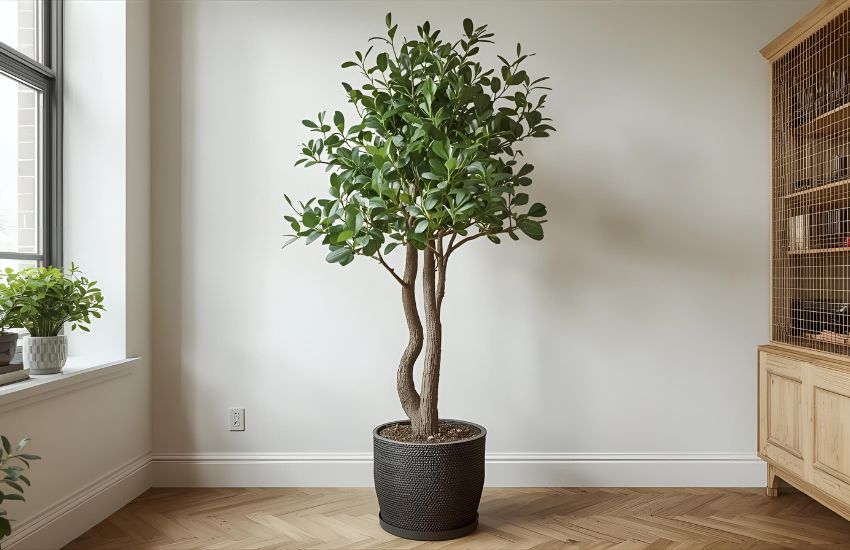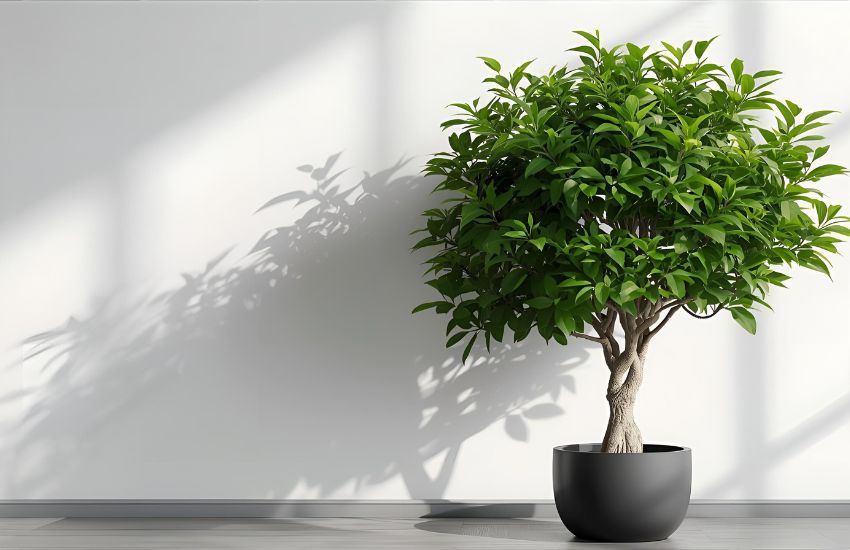Ficus Netted Microcarpa stands out as a versatile and elegant choice for anyone looking to enhance their indoor space. Its glossy, vibrant leaf patterns bring a touch of nature’s artistry into your home, while its manageable size makes it perfect for both floor display and tabletop arrangements. You will find that this fig plant is not only visually striking but also resilient, able to thrive in moderate indoor conditions when provided with proper water, soil, and pot care.
Whether you prefer to cultivate it as a compact bonsai or allow it to grow naturally, the Ficus Netted Microcarpa responds well to consistent attention, rewarding you with lush foliage and a graceful presence. Its close relation to ficus retusa gives it similar adaptability, making it suitable for varied humidity levels and indoor lighting situations.
In this guide, you will discover practical tips on selecting the right pot, optimizing soil, and establishing a watering routine that helps your fig thrive. You will also learn how to maintain its foliage, explore bonsai techniques, and ensure your indoor fig remains a timeless statement of greenery and style.
Optimal Water and Fertilization Tips for Thriving Ficus Plant Growth

- Maintaining a healthy netted ficus tree relies on careful water and fertilization routines to support glossy foliage and vibrant growth.
- Practice moderate watering: allow the top layer of soil to dry slightly before rewatering to prevent root rot or yellow leaves.
- Avoid overwatering, which can cause yellow leaves, and underwatering, which may stunt shoot development or cause leaf drop.
- Place your ficus plant in indirect light; occasional gentle sunlight exposure helps maintain dark green leaves.
- Use a balanced, slow-release fertilizer during active growth to promote strong shoots and abundant green leaves.
- Lightly mist the foliage to increase humidity, helping the plant tolerate indoor environments with lower moisture.
- Regularly prune weak or overgrown shoots to shape the plant and preserve its classic appearance.
- When selecting from a nursery, choose a specimen with healthy, dark green leaves and minimal signs of stress.
- This indoor plant is generally safe around pets with basic precautions.
- Following these water and fertilization tips ensures your ficus plant thrives under optimal growing conditions.
Netted Ficus Microcarpa Tree Care Guide for Modern Indoor Green Serenity

The netted ficus microcarpa, also known by its common names such as the ginseng ficus, is a distinctive indoor plant admired for its thick, sculptural trunk and lush canopy of green leaves. In the world of houseplants, it is particularly valued for its ability to purify air by absorbing certain pollutants, making it both a decorative and functional addition to your home. Its thick root structure and foliage make it ideal for creating a serene, modern indoor space.
Light and Placement
To maintain optimal health, position your netted ficus in partial shade or bright indirect sunlight. While the plant can tolerate some direct sunlight, prolonged exposure may scorch its leaves. The goal is to provide sufficient light for photosynthesis while preventing damage to its foliage.
Watering and Moisture
This ficus tree thrives when you maintain consistent moisture in the soil, but avoid waterlogging. A mix containing peat enhances water retention while ensuring proper drainage. Regularly check the soil and water when the top layer feels dry, particularly during the spring and summer, when growth is most active.
Fertilization and Growth
Fertilization is essential to encourage healthy shoots and a dense canopy. During the growing season, apply a balanced liquid or slow-release fertilizer every few weeks. Proper fertilization ensures your plant develops strong roots and glossy leaves, while a seasonal reduction in nutrients during winter allows the tree to rest.
Humidity and Environmental Care
The netted ficus appreciates high humidity, so consider occasional misting to mimic its native tropical environment. Keep it away from sources of irritation, drafts, or sudden temperature changes, as these can stress the plant. While generally safe, avoid ingestion by children or pets, as its sap may cause mild irritation.
Conclusion
Caring for your netted ficus microcarpa allows you to enjoy its lush foliage, sculptural bark, and vibrant vein patterns, all while it works to purify your indoor air. Avoiding overwatering, underwatering, or poor drainage will prevent root rot, leaf drop, and other common issues. Providing balanced nutrient support and maintaining a tropical environment ensures your plant thrives, producing a dense, healthy canopy that enhances any space. Regular checks for pests like aphids and careful attention to watering routines will keep your ficus resilient and beautiful.
Bring home the timeless elegance of a netted ficus microcarpa today and transform your indoor environment into a serene, green sanctuary. Nurture it properly, and it will reward you with years of lush growth, refined structure, and a natural focal point in your home. Start your ficus journey now and experience the perfect blend of beauty and air-purifying benefits!
Frequently Asked Questions (Ficus Netted Microcarpa: A Timeless Ficus Plant and Tree for Modern Indoor Beauty)
Is Ficus microcarpa a good indoor plant?
Yes, Ficus microcarpa is a good indoor plant because it adapts well to indoor conditions and adds aesthetic appeal with its glossy leaves and attractive shape. It requires bright, indirect light, moderate watering, and occasional pruning, making it manageable for indoor growth and decoration.
Is Ficus microcarpa a lucky plant?
Yes, Ficus microcarpa is considered a lucky plant in many cultures, especially in Feng Shui. It is believed to attract positive energy, prosperity, and good fortune when placed indoors. Its lush green leaves symbolize growth, harmony, and a thriving environment, enhancing overall well-being.
What does the Ficus microcarpa symbolize?
Ficus microcarpa symbolizes abundance, prosperity, and protection. Often associated with good luck and positive energy, it is believed to attract wealth and harmony into homes and offices. Its resilience and longevity also represent stability, endurance, and spiritual growth in many cultures and traditions.
What is the best ficus tree for indoors?
The best indoor ficus trees are Ficus elastica (rubber plant), Ficus benjamina (weeping fig), and Ficus lyrata (fiddle-leaf fig). Ficus elastica is known for its glossy, dark green leaves and adaptability to various light conditions. Ficus benjamina offers elegant foliage and air-purifying qualities. Ficus lyrata features large, sculptural leaves, adding a bold aesthetic to interiors. All require bright, indirect light and moderate watering.
